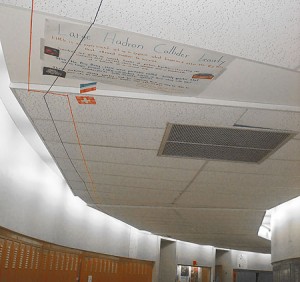Why I converted my school into a particle accelerator
As the 2007-2008 school year was coming to a close, I came across an article written in the New York Times by physicist Dr. Brian Greene. With graduation just days away, final grades to enter and textbooks to collect, I skimmed through the article and went back to closing out the school year. Yet, I could not get the points in Dr. Greene’s article out of my head. All summer long, it kept me thinking about how I teach science.
Dr. Greene’s article, Put a Little Science in Your Life, emphasized the importance of making time in your science lessons to discuss the big questions. He argued that topics like the formation of the universe or origins of life take a back seat because we are too focused on working our way through our standards-driven curriculum. Dr. Greene points out that science teachers are shackled to a sequence of topics laid out in our curriculum which leaves no room for discussions about cutting-edge experiments and discoveries that are happening right now.
Dr. Greene wrote:
We rob science education of life when we focus solely on results and seek to train students to solve problems and recite facts without a commensurate emphasis on transporting them out beyond the stars.
As a physics teacher, I start each year teaching motion, then forces and so on. Almost every concept in our physics curriculum was nailed down over 400 years ago. But Dr. Greene’s article got me thinking- what about the physics that is being investigated today? Modern physics is full of extraordinary stories. It deserves to be showcased with more than a few videos and a couple Einstein activities scattered throughout the year.
So now I’ve entered the 2008-2009 school year with a new goal- to weave current, cutting-edge science into my lessons. Fortunately, the Large Hadron Collider (LHC) went online early this morning. To mark the event, my students converted our school’s third floor into a model of the new accelerator (it helps that I teach in a round school). We strung yarn around our circular hallway to represent the two beams. Students hung posters along the hallway that described things like quarks, string theory and the Big Bang. Other students put up posters where the yarn beams cross to describe the experiments that are taking place in our model of the LHC.
This year I still plan to teach motion and forces, but my examples won’t be just about cars, arrows or balls. I hope to throw in a proton or muon from time to time too.

Fantastic idea. I wish I could have done something like this in high school.
Standards are good and necessary but what is needed even more is this kind of inspired teaching. This is the lesson that students talk about over the dinner table and in the hallways. Yes, this teaching is spur of the moment, but it is also fundamentally grounded in basic physics. These high school students were learning about cutting edge science which is fantastic but it was also an example of teaching and learning at the cutting edge of science education. Can we train teachers to think in creative ways about how they approach a lesson? I’m concerned that this kind of teaching, sharing and constuctive learning occurs less often now because of the strictures of curricula designed to “meet the standards”
As soon as you mentioned a round school, appleton east was the first thing that popped into my head. I’ve only been there on a couple occasions but I always wondered what a round school would be good for. Now I know.
Here’s a link to make a table top particle accelerator: https://www.kqed.org/quest/television/make-it-at-home-tabletop-linear-accelerator